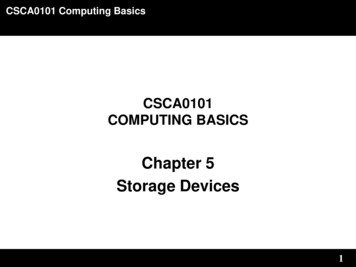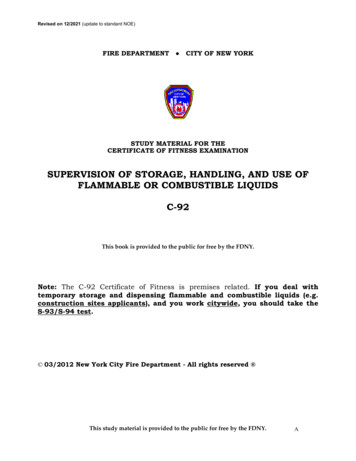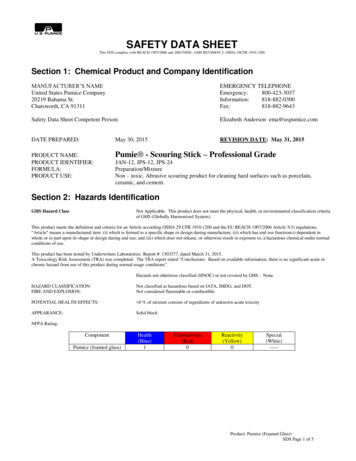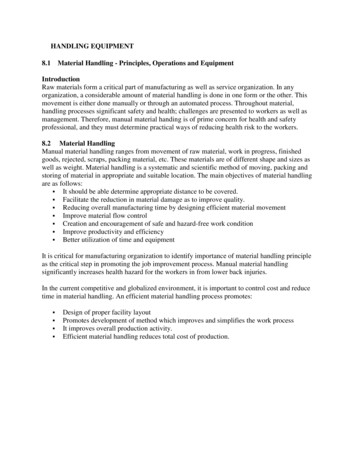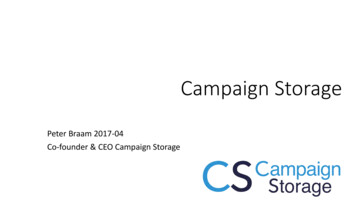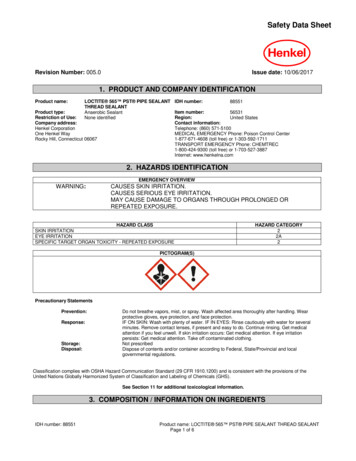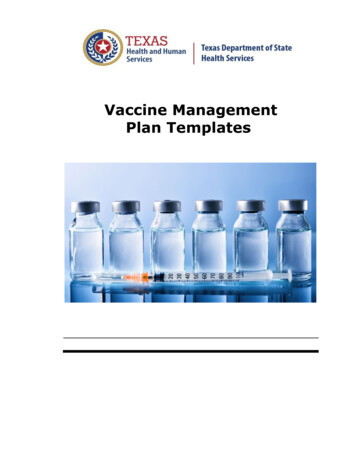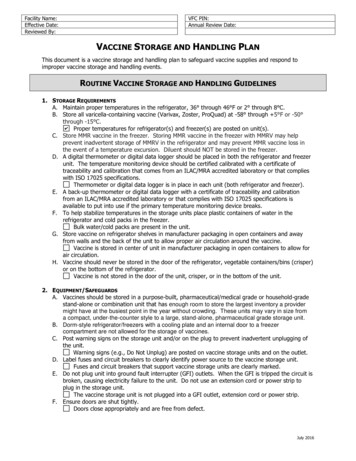
Transcription
Facility Name:Effective Date:Reviewed By:VFC PIN:Annual Review Date:VACCINE STORAGE AND HANDLING PLANThis document is a vaccine storage and handling plan to safeguard vaccine supplies and respond toimproper vaccine storage and handling events.ROUTINE VACCINE STORAGE AND HANDLING GUIDELINES1. STORAGE REQUIREMENTSA. Maintain proper temperatures in the refrigerator, 36 through 46 F or 2 through 8 C.B. Store all varicella-containing vaccine (Varivax, Zoster, ProQuad) at -58 through 5 F or -50 through -15 C. Proper temperatures for refrigerator(s) and freezer(s) are posted on unit(s).C. Store MMR vaccine in the freezer. Storing MMR vaccine in the freezer with MMRV may helpprevent inadvertent storage of MMRV in the refrigerator and may prevent MMR vaccine loss inthe event of a temperature excursion. Diluent should NOT be stored in the freezer.D. A digital thermometer or digital data logger should be placed in both the refrigerator and freezerunit. The temperature monitoring device should be certified calibrated with a certificate oftraceability and calibration that comes from an ILAC/MRA accredited laboratory or that complieswith ISO 17025 specifications.Thermometer or digital data logger is in place in each unit (both refrigerator and freezer).E. A back-up thermometer or digital data logger with a certificate of traceability and calibrationfrom an ILAC/MRA accredited laboratory or that complies with ISO 17025 specifications isavailable to put into use if the primary temperature monitoring device breaks.F. To help stabilize temperatures in the storage units place plastic containers of water in therefrigerator and cold packs in the freezer.Bulk water/cold packs are present in the unit.G. Store vaccine on refrigerator shelves in manufacturer packaging in open containers and awayfrom walls and the back of the unit to allow proper air circulation around the vaccine.Vaccine is stored in center of unit in manufacturer packaging in open containers to allow forair circulation.H. Vaccine should never be stored in the door of the refrigerator, vegetable containers/bins (crisper)or on the bottom of the refrigerator.Vaccine is not stored in the door of the unit, crisper, or in the bottom of the unit.2. EQUIPMENT/SAFEGUARDSA. Vaccines should be stored in a purpose-built, pharmaceutical/medical grade or household-gradestand-alone or combination unit that has enough room to store the largest inventory a providermight have at the busiest point in the year without crowding. These units may vary in size froma compact, under-the-counter style to a large, stand-alone, pharmaceutical grade storage unit.B. Dorm-style refrigerator/freezers with a cooling plate and an internal door to a freezercompartment are not allowed for the storage of vaccines.C. Post warning signs on the storage unit and/or on the plug to prevent inadvertent unplugging ofthe unit.Warning signs (e.g., Do Not Unplug) are posted on vaccine storage units and on the outlet.D. Label fuses and circuit breakers to clearly identify power source to the vaccine storage unit.Fuses and circuit breakers that support vaccine storage units are clearly marked.E. Do not plug unit into ground fault interrupter (GFI) outlets. When the GFI is tripped the circuit isbroken, causing electricity failure to the unit. Do not use an extension cord or power strip toplug in the storage unit.The vaccine storage unit is not plugged into a GFI outlet, extension cord or power strip.F. Ensure doors are shut tightly.Doors close appropriately and are free from defect.July 2016
3. TEMPERATURE MONITORINGA. A thermometer or digital data logger is in place in each unit (both refrigerator and freezer). See1. D. All VFC providers will be required to transition to digital data loggers by January 2018.Thermometer or digital data logger is in place in each unit (both refrigerator andfreezer).B. A back-up thermometer or digital data logger is available to put into use if the primarytemperature monitoring device breaks. See 1. E.C. The designated person checks and records refrigerator and freezer temperatures twice daily (atthe beginning and end of each work day) and records the time and name/initials associated witheach temperature reading.D. Storage temperatures should be recorded on a temperature log and maintained for at least 3years. This is useful to identify the duration of temperature variations. If a digital data loggerhas the capability to annotate an electronic temperature check with the time and initials of theperson checking the temperature, then it is not necessary to manually log the temperaturechecks at each temperature check.Refrigerator and freezer temperatures are checked and recorded on a temperature log twicedaily along with staff initials and time of readings. Storage temperature logs are maintained for atleast 3 years for each unit either in electronic or paper format (see 3. D. description for electronicstorage criteria).E. If a temperature outside of the recommended range is found, immediate action should be takento correct the problem as outlined in the standard operating procedures for improper vaccinestorage and handling section. Actions taken should be documented on the Vaccine StorageTroubleshooting Record.Clinic staff is trained to take immediate action if temperatures are out of range.F. The backup person should review the temperature log at least weekly to ensure propertemperature recording and take action if out of range temperatures are found on the logs duringreview. If a digital data logger is used, the data should be downloaded, reviewed and data filestored every 2 weeks.The designated backup person reviews temperature logs at least weekly.G. Consideration should be given to how power failures or out of range temperature will beidentified during non-business hours.4. VACCINE ORDERINGHealth care providers participating in the VFC Program are responsible for ordering and maintainingadequate vaccine inventory for eligible patients to prevent missed opportunities. The IowaDepartment of Public Health, Vaccine for Children Program requires VFC providers to place vaccineorders using the Immunization Registry Information System (IRIS). IRIS contains vaccine orderfunctionality which includes recommended order quantities based on ordering patterns and dosesadministered data. When placing vaccine orders, review recommended order quantities for eachvaccine and total amount of vaccine needed including combination and single antigen products.Review current inventory/expiration dates and consider seasonal events or specialty clinics.Clinic staff is aware of Economic Order Quantity.Clinic staff is trained regarding vaccine ordering.Do not over-order or stockpile vaccine.Maintain adequate inventory of VFC and private vaccine (if applicable) to eliminateoccurrences of borrowing between VFC and private inventories.5. RECEIVING VACCINEDevelop and post a protocol for accepting vaccine deliveries that indicates who in the practice mayaccept vaccine shipments to ensure vaccines are stored appropriately and IMMEDIATELY afterarrival. Train staff how to compare the vaccine received with the vaccine invoice.Cold and heat indicators should be reviewed immediately to ensure vaccine was maintained at theappropriate temperatures during shipping. Alert the Vaccines for Children (VFC) Program at 1-800-July 2016
831-6293 if the vaccine is not in proper condition, the number of doses is different than what is onthe invoice, or if the lot number is recorded incorrectly on the invoice.Protocol is posted for all staff regarding vaccine deliveries and whom to contact regardingvaccine shipments.Clinic staff ensure vaccine shipments are stored properly immediately upon arrival.Clinic staff is trained how to compare vaccine received to the vaccine invoice and will alertthe VFC Program if vaccine doses do not match the invoice or if they are not in propercondition upon arrival.Maintain vaccine packing slips for both VFC and private vaccine inventory for a minimum ofthree years.6. VACCINE MANAGEMENT/STOCK ROTATIONCheck and rotate your stock monthly or when new vaccine inventory arrives. Ensure vaccine with themost current expiration dates are used first and are in front of vaccines with longer expiration dates.Conduct count of vaccine inventory at least monthly.Rotate vaccine stock regularly; move earliest expiration dates to the front.Check vaccine expiration dates at least monthly.Clinic staff is able to distinguish VFC vaccine from private vaccine.Report VFC vaccine that will not be used and will expire within 2-3 months to the Iowa VFCProgram at 1-800-831-6293.7. STAFFING/TRAININGPost the Vaccine Storage and Handling Plan on or near the vaccine storage units and ensure all staffare trained regarding the plan. Review the current guidelines for handling of individual vaccines thatmay include special instructions (e.g., protect from light, shelf life after reconstitution). Understandpackage inserts for new vaccines before using. Additional references include the Centers for DiseaseControl and Prevention (CDC)’s “You Call the Shots, Vaccine Storage and Handling” available tmlVaccine Storage and Handling plan is posted on or near storage unit.All staff is trained on the plan and training is documented (minimum of annually).Staff is trained on guidelines for handling individual vaccines with special instructions.Staff who administers vaccine have read and understand package inserts prior toadministering vaccine.Staff has access to manufacturer’s package inserts for each vaccine on hand and the CDCEpidemiology and Prevention of Vaccine Preventable Diseases (Pink book).8. DESIGNATED PERSON(S)Designate a primary and a backup person to:Monitor the operation of the vaccine storage units and systems.Set up and maintain a monitoring/notification system during times of inclement weather orother conditions that would create an interruption of power.Ensure the appropriate handling of the vaccine during a disaster or power outage.Ensure access to the building where vaccines are stored 24 hours per day.Primary Person:Phone:Secondary Person:Phone:Additional Staff:Phone:9. BACK-UP SUPPLIES/FACILITYIt is important to have a back-up plan to appropriately store vaccine. Make formal arrangements(memorandum of understanding) with a backup facility to maintain vaccine if your vaccine storageequipment malfunctions or there is a power outage. Train a designated person and backup person atJuly 2016
the facility to accept your vaccine if it must be moved. Before moving your vaccine, call the locationto ensure their facility is available to store the vaccine (e.g., not damaged due to storms). If theback-up facility is not available contact the other facilities on your backup facility list.BACK-UP FACILITIES CONTACT INFORMATIONName of FacilityPrimary & Back-up ContactContact Phone Number Work/Home/CellEMERGENCY CONTACT LISTList of emergency phone numbers, companies, and points of contact:Electric Power Company:Temperature Alarm Monitoring Company:Refrigerator Repair Company:Transportation to Back-up Storage:Emergency Generator Repair Company:National Weather Service:FACILITY FLOOR PLANEntering vaccine spaces: Describe, when necessary, how to enter the building and vaccine storagespaces in an emergency if closed or after hours. Include a simple floor diagram (does not need to bea blue print) and the locations of:Storage units:Doors:Flash lights:Spare batteries:Light switches:Keys:Locks:Alarms:Circuit breakers:Packing materials:July 2016
EMERGENCY VACCINE RETRIEVAL AND STORAGE GUIDELINES1. RESPONSE TO IMPROPER VACCINE STORAGE AND HANDLINGASSESS THE SITUATIONa. Determine the cause of improper vaccine temperatures (e.g., mechanical failure, poweroutage, natural disaster, human error).b. Store the vaccines at appropriate temperatures. Determine if vaccine should be moved andmove if appropriate.c. Record the current temperature of the refrigerator/freezer.d. Mark the vaccine “Do Not Use” so the potentially compromised vaccines can be easilyidentified and not used until viability of vaccine is determined.e. Collect essential data on the Emergency Vaccine Response Worksheet.f. Call the Iowa Immunization Program (1-800-831-6293).g. Call all manufacturers of affected vaccine(s).2. PACK VACCINEa. Open refrigerated units only when absolutely necessary and only after you have made allpreparations for packing and moving the vaccine to alternative storage site.b. Use hard sided coolers with at least 2 inch walls, or portable refrigeration units, to transportvaccine supply.c. Pack the refrigerated vaccines first with an adequate supply of cold packs (add packingmaterial so cold packs are not in direct contact with the vaccine). For transport of refrigeratedvaccines ice packs should be conditioned by placing them at room temperature for at least 1hour prior to packing or by running under cold water until freely movable withing thepackaging.d. The manufacturer of varicella-containing vaccines, Merck, recommends the vaccines (Varivax,Zoster, ProQuad) NOT be transported on dry ice. Use of dry ice may subject the vaccines totemperatures colder than -58 F (-50 C). Several companies make portable freezer units.NOTE: In the event the vaccine must be moved due to emergency situations and a portablefreezer unit is not available, Varicella-containing vaccine should be moved in a separate coolerfrom the refrigerator vaccines. The cooler containing varicella vaccines should be packed withas many ice packs as possible and a thermometer placed in the cooler. The time andtemperature must be monitored and recorded until vaccine is stored under proper conditionsin an approved storage unit. Once the vaccine has been stored appropriately the IowaImmunization Program and the manufacturer must be contacted prior to using the vaccine.e. Include a thermometer with a certificate of calibration with the vaccine in each cooler tomonitor the vaccine temperature during transport. It is recommended that a digitalthermometer with a detachable probe in a buffered material be used so that temperaturereadings can be obtained during transport without opening the transport container.3. MOVE VACCINEa. If alternative storage is available within your facility transfer vaccine to that storage unit. Ifnot, contact your backup facility to notify them of your refrigerator/freezer failure and theneed to store vaccine at their location.b. Prior to transporting vaccine, record the time and the temperature of the refrigerator(s) andfreezer(s) units. This will provide data on the maximum temperature and duration ofexposure of vaccine to inappropriate temperatures.c. Conduct an inventory before you transport the vaccine.d. Transport the vaccine following proper cold chain procedures for storage and handling.e. Isolate and maintain vaccines at appropriate temperatures and do not administer or discardvaccine until you have contacted the Iowa Immunization Program (1-800-831-6293) forconsultation.July 2016
4. POST EVENTKeep exposed vaccine separated from unaffected vaccine and any new vaccine you receive.Maintain vaccines at appropriate temperatures and do not administer or discard any potentiallyexposed vaccine until you have contacted the Iowa Immunization Program (1-800-831-6293) forconsultation.5. VACCINE WASTAGENever assume vaccine is nonviable in the event of a storage problem or handling issue. Contactthe Iowa VFC Program immediately (1-800-831-6293) for instructions regarding VFC vaccine.Vaccines determined to be non-viable should be documented appropriately on the NonviableVaccine Return Form and reported to the VFC Program Coordinator. Document vaccine lossusing appropriate reasons provided in IRIS. Expired and wasted vaccines should be returned toMcKesson; refer to the VFC Non-viable Vaccine Return Form for instructions.July 2016
EMERGENCY VACCINE RESPONSE CONTACT LISTPost on outside of refrigeratorVaccine Storage and Handling Staff:Primary:Phone:Secondary:Phone:Staff with 24 hour access:Phone:Additional Staff:Phone:Emergency Contact List:Backup Storage Facility:Phone:Backup Storage Facility:Phone:Electric Power Company:Phone:Refrigerator Repair Company:Phone:Temperature Alarm Monitoring Company:Phone:Transportation to Backup Storage:Phone:Emergency Generator Repair Company:Phone:National Weather Service:Phone:Fuel for Generator:Phone:Vaccine Storage and Handling Events:1. Determine the cause of improper vaccine temperatures (e.g., mechanical failure, power outage,natural disaster, human error).2. Store the vaccines at appropriate temperatures. Determine if vaccine should be moved and move ifappropriate. See “Packing Vaccines for Transport during Emergencies” job aid.3. Record the current temperature of the refrigerator/freezer.4. Mark the vaccine so that the potentially compromised vaccines can be easily identified and not useduntil viability of vaccine is determined.5. Collect essential data on the Emergency Vaccine Response Worksheet (attach additional copies ifnecessary).6. Call the Iowa Immunization Program (1-800-831-6293).7. Call all manufacturers of affected vaccine(s).July 2016
EMERGENCY VACCINE RESPONSE WORKSHEETFacility Name:VFC PIN:Date of event:Handling Error:Current refrigerator temperature: F/ CMin/Max (Circle) refrigerator temperature reached:Current freezer temperature: F/ CMin/Max (Circle) freezer temperature reached:Total length of time temperature was outside normal range for refrigerator:or freezer: F/ C F/ CLot NumberExpirationDateNumberof /ManufacturerLot NumberExpirationDateNumberof REFRIGERATORVaccine/ManufacturerVACCINE MANUFACTURERSVaccineIPV, Tripedia, Daptacel, TriHIBit, DT, Td, ActHib, Fluzone, RIG, Imovax, JE-VAX, Menomune, Typhim Vi, YF-VAX, Adacel,Menactra, Pentacel, Decavac, PPD, QuadracelRecombivax HB, MMR, Varivax, PedvaxHIB, Comvax, Pneumovax, Vaqta, RotaTeq, Gardasil, Zostavax, ProQuadInfanrix, Pediarix, Engerix B, Havrix, Twinrix, Boostrix, Fluarix, Kinrix, Rotarix, FluLaval, Cervarix, Hiberix, Menhibrix, BexseroPrevnar, TrumenbaImmune GlobulinNabi HB (Hep B Immune Globulin)Synagis, FlumistRabAvert, Fluvirin, Agriflu, MenveoManufacturerPhoneSanofi 3-5899AfluriaCSL Biotherapies1-888-435-8633July 2016
VACCINE STORAGE AND HANDLING TRAINING LOGStaffName of TrainingTraining DateJuly 2016
Primary Person: Phone: Secondary Person: Phone: Additional Staff: Phone: 9. BACK-UP SUPPLIES/FACILITY . It is important to have a back-up plan to appropriately store vaccine. Make formal arrangements (memorandum of understanding) with a backup facility to maintain vaccine if your vaccine storage equipment malfunctions or there is a power outage.

